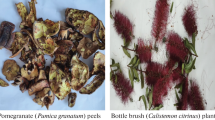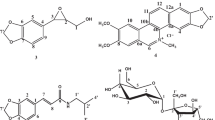Abstract
Spices are well known for their taste and flavor imparting properties. Green cardamom (Elletaria cardamomum), a herb spice belongs to family Zingiberaceae. In current study, GC–MS analysis of green cardamom essential oil (CEO) resulted in identification of twenty-six compounds with α-terpinyl acetate (38.4%), 1,8-cineole (28.71%), linalool acetate (8.42%), sabinene (5.21%), and linalool (3.97%) as major bioactive components. Present study also described the antimicrobial properties like zone of inhibition, minimum inhibitory concentration against microbial strains with special emphasis on quorum sensing inhibition. Disk diffusion assay showed that C. albicans and S. mutans were the most sensitive microorganisms followed by S. aureus, L. monocytogenes, B. cereus and S. typhimurium sensor strains, respectively. Whilst P. aeruginosa was found most resistant strain as CEO did not inhibited its growth. The minimum inhibitory concentration (MIC) values of CEO against tested strains were 10 ± 0.00 mg/mL against S. typhimurium, S. aureus and 5 ± 0.00 mg/mL against S. mutans, C. albicans strains, respectively. Regarding quorum sensing inhibition the tested concentrations 0.625 and 0.313 mg/mL of CEO inhibited violacein production with very little effect on growth of C. violaceum. Conclusively, study proved that quorum sensing inhibition values of CEO were much lower compared to MIC revealed values. Hence, cardamom bioactive constituents can effectively be used to develop novel antimicrobial drugs against conventional antibiotics.





Similar content being viewed by others
References
Adams RP (2005) Identification of essential oil components by gas chromatography/mass spectrometry. J Am Soc Mass Spectrom 16:1902–1903
Amma KPAP, Rani MP, Sasidharan I, Nisha VNP (2010) Chemical composition, flavonoid—phenolic contents and radical scavenging activity of four major varieties of cardamom. Int J Biol Med Res 1:20–24
Aneja K, Radhika J (2009) Antimicrobial activity of Amomum subulatum and Elettaria cardamomum against dental caries causing microorganisms. Ethnobotan Leafl 13:849
AOAC (2006). Official methods of analysis, 18th edn. Washington DC
Belapurkar R, Tale VS, Madkaikar R (2014) Exploiting quorum sensing to inhibit the bacterial pathogens. Int J Curr Microbiol App Sci 3:453–458
Bhatti HN, Zafar F, Jamal MA (2010) Evaluation of phenolic contents and antioxidant potential of methanolic extracts of green cardamom (Elettaria cardamomum). Asian J Chem 22:4787–4794
CLSI (2007) Methods for antimicrobial susceptibility testing of anaerobic bacteria; approved standard—Seventh Edition, M11-A7
CLSI (2012) Performance standards for antimicrobial disk susceptibility tests; approved standard—Eleventh Edition, M02-A11
El-Yamani MAS (2011) Cinnamon, cardamom and ginger impacts as evaluated on hyperglycemic rats. Res J Specif Educ 20:667–676
Hamzaa RG, Osman NN (2012) Using of coffee and cardamom mixture to ameliorate oxidative stress induced in γ-irradiated rats. Biochem Anal Biochem 1:113–119
Hossain MB, Bruntonb NB, Barry-Ryana C, Martin-Dianaa AB, Wilkinson M (2008) Antioxidant activity of spice extracts and phenolics in comparison to synthetic antioxidants. Rasayan J Chem 1:751–756
Jamal A, Siddiqui A, Aslam M, Javed K, Jafri M (2005) Antiulcerogenic activity of Elettaria cardamomum Maton. and Amomum subulatum Roxb. seeds. Indian J Trade Knowl 4:298–302
Kapoor IPS, Singh B, Singh G, Isidorov V, Szczepaniak L (2008) Chemistry, antifungal and antioxidant activities of cardamom (Amomum subulatum) essential oil and oleoresins. Int J Essent Oil Ther 2:29–40
Kaushik P, Goyal P, Chauhan A, Chauhan G (2010) In vitro evaluation of antibacterial potential of dry fruitextracts of Elettaria cardamomum Maton (Chhoti Elaichi). Iran J Pharm Res 9:287
Khalaf NA, Shakya AK, Al-Othman A, El-Agbar Z, Farah H (2008) Antioxidant activity of some common plants. Turk J Biol 32:51–55
Menon AN, Chacko S, Narayanan CS (1999) Free and glycosidically bound volatiles of cardamom (Elettaria cardamomum Maton var. miniscula Burkill). Flav Fragr J 14:65–68
Niu C, Gilbert ES (2004) Colorimetric method for identifying plant essential oil components that affect biofilm formation and structure. Appl Environ Microbiol 70:6951–6956
Rahmatullah M, Noman A, Hossan MS, Rashid M, Rahman T, Chowdhury MH, Jahan R (2009) A survey of medicinal plants in two areas of Dinajpur district, Bangladesh including plants which can be used as functional foods. Am Eur J Sustain Agric 3:862–876
Savan EK, Kucukbay FZ (2013) Essential oil composition of Elettaria cardamomum Maton. J Appl Biol Sci 7:42–45
Sharma S, Sharma J, Kaur G (2011) Therapeutic uses of Elettaria cardamomum. Int J Drug Formul Res 2:102–108
Shukla S, Mistry H, Patel V, Jogi B (2010) Pharmacognostical, preliminary phytochemical studies and analgesic activity of Amomum subulatum Roxb. Pharm Sci Monit 1:90–102
Singh G, Kiran S, Marimuthu P, Isidorov V, Vinogorova V (2008) Antioxidant and antimicrobial activities of essential oil and various oleoresins of Elettaria cardamomum (seeds and pods). J Sci Food Agric 88:280–289
Sultana S, Ali M, Ansari SH, Bagri P (2009) Effect of physical factors on the volatile constituents of Elettaria cardamomum fruits. J Essent Oil Bear Plants 12:287–292
Torres M, Rubio-Portillo E, Anton J, Ramos-Espla AA, Quesada E, Llamas I (2016) Selection of the N-acylhomoserine lactone-degrading bacterium alteromonasstellipolaris PQQ-42 and of Its potential for biocontrol in aquaculture. Front Microbiol 7:646
Verma SK, Jain V, Katewa SS (2009) Blood pressure lowering, fibrinolysis enhancing and antioxidant activities of cardamom (Elettaria cardamomum). Indian J Biochem Biophys 46:503–506
Zhao J, Chen M, Quan CS, Fan SD (2015) Mechanisms of quorum sensing and strategies for quorum sensing disruption in aquaculture pathogens. J Fish Dis 38:771–786
Zhu H, He CC, Chu QH (2011) Inhibition of quorum sensing in Chromobacterium violaceum by pigments extracted from Auricularia auricular. Lett Appl Microbiol 52:269–274
Acknowledgements
We are thankful to Shimadzu Scientific Instruments (19 Schoolhouse Road, Suite 107, Somerset, NJ, 08873) for providing the GC–MS instrument in support of the research work of the Center for Sensory Sciences and Innovation at Rutgers University. We also acknowledged the support of Department of Biochemistry and Microbiology, Rutgers, The State University of New Jersey. We also wish to thank Higher Education Commission (HEC), Pakistan for providing financial assistance to support the Ph.D. research work.
Author information
Authors and Affiliations
Corresponding author
Rights and permissions
About this article
Cite this article
Abdullah, Asghar, A., Butt, M.S. et al. Evaluating the antimicrobial potential of green cardamom essential oil focusing on quorum sensing inhibition of Chromobacterium violaceum . J Food Sci Technol 54, 2306–2315 (2017). https://doi.org/10.1007/s13197-017-2668-7
Revised:
Accepted:
Published:
Issue Date:
DOI: https://doi.org/10.1007/s13197-017-2668-7




